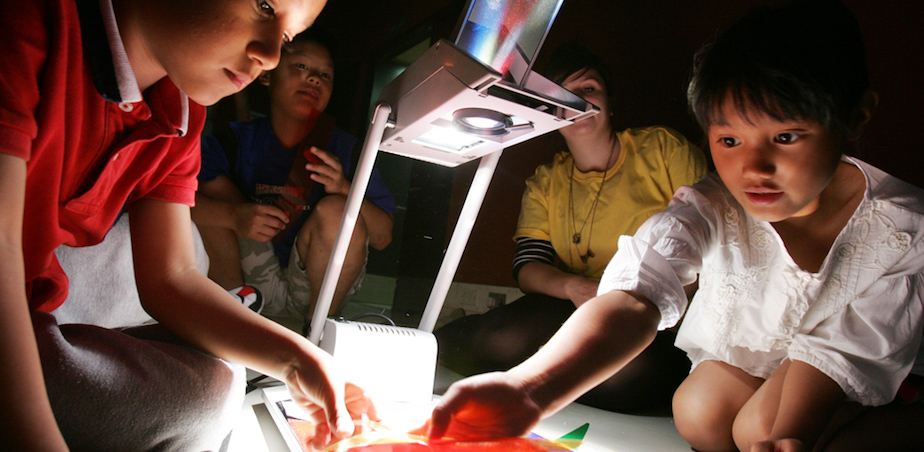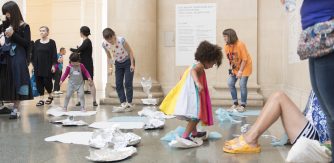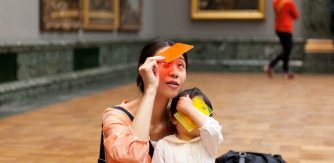Blog 1 – Jean Tormey, Curator Early Years & Families at Tate Modern & Tate Britain

Early Years Open Studio, Image – Open Studio

Jean Tormey is Curator of the Early Years and Families programme of resources, events and projects at Tate Modern and Tate Britain for under 5s, 8-14s and intergenerational audiences. She has worked on Families’ programming in galleries since 2008. Her practice involves working with artists, audiences and colleagues at Tate to develop content and activity through which diverse children and families can be considered as equal and valued visitors to Tate. Jean has worked in gallery learning since 2005 as an intern in New York and as a learning curator in different galleries in Liverpool, Kilkenny and London.
Inspiration for Tate’s EYF programme – the Reggio Emilia approach
“The child is not a citizen of the future; they are a citizen from the very first moment of life and also the most important citizen because they represent and bring the ‘possible’… a bearer, here and now of rights, of values, of culture… It is our historical responsibility not only to affirm this, but to create cultural, social, political and educational contexts which are able to receive children and dialogue with their potential for constructing human rights.” Carlina Rinaldi, In Dialogue with Reggio Emilia: Listening, Researching and Learning
When I took up the post of Early Years and Families (EYF) Curator at Tate, most of my experience was with families’ programming aimed at 5-12 year olds, with under 5s included as part of an intergenerational group, or where activity was primarily aimed at parents with an understanding that early years are welcome.[i]
I was introduced to the theory influencing Tate’s EYF programme – the Reggio Emilia approach[ii] – by the Convenor of the programme, Susan Sheddan[iii], and through working on the programme have learnt about the potential of the gallery to be used as an important site of learning and communication specifically for this agegroup.
The infant and toddler schools of Reggio offer places to 0-6 year olds and consist of a mixture of municipal, state, public and private schools. The aims of the schools are to involve their community in participatory consultation in all aspects of their running, to be transparent and shared in this approach, to give substance and voice to the rights of children, parents and teachers, and to improve the quality of life of children in the city overall. Each centre has a pedagogista, teacher, atelierista and cook. Children and parents are involved in the running of each centre, which is closely connected to its context. The process of how people communicate and when is of utmost importance to the streamlined running of the centre.
The learning principles of Reggio are that children must have some control over the direction of their learning, be able to learn through experiences of touching, moving, listening, seeing and hearing; have a relationship with other children and with material items in the world that they must be allowed to explore, and have endless ways and opportunities to express themselves. I had the opportunity to visit Reggio Emilia for a study week in spring 2014 and came away with the following highlights relevant to my work at Tate. These are reflected in the EYF team’s current values or ‘non-negotiables’ of agency, curiosity, diversity and openness.
“The best we can be”: Carla Rinaldi, president of Reggio Children, talks about childhood as a quality (not just a stage of life), and about it representing ‘the best we can be’. She describes children as being in a constant state of searching for meaning and understanding in the world – interpreting their surroundings to find answers in life. The Reggio approach sees children as keen, sensitive observers with the potential to fill flexible contexts and generative environments with meaning.
Diffused atelier: There is an atelier (studio) and atelierista (studio artist) in every Reggio school. Atelieristas are considered to have heightened awareness of contemporary culture, know how to interpret art, and have a unique perspective on learning. They work as co-constructors with teachers, students and parents to create contexts for learning a range of different subjects – the process for which can be compared to an artist developing work in their studio. The atelier, a metaphor for the Reggio approach as a whole, pervades the public space of the school so that everyone involved can influence the atelier and come together to co-construct meaning.
Co-researchers: The role of the teacher is as researcher alongside the children (with parents and artists). This might include exploring existing theories together, but also developing new theories and going to new places of learning as a result of exploration. Parents are involved as much as possible in the building of shared value.
Traces of learning: In order to research alongside children, observation (of and by children) is a key process used by Reggio teams – with drawing being used as a consistent tool for this, revealing traces of learning. Active listening, consulting with and talking to children about what they have noticed or observed develops critical thinking skills among children.
Exchange: The Reggio approach is highly influenced by Lev Vygotsky and the belief that psychological development occurs through interpersonal connections, actions and play in small groups. Children have a predisposal to creating relations and engaging in exchange. This is encouraged in Reggio schools by adults offering their point of view ready for children to offer theirs, using a range of the so called ‘100 languages’ Reggio deem children to have.
Education is political: Reggio is a political project, ultimately trying to change the status of EY schools nationally in Italy from service providers to education centres. They consistently refer to the rights of children and to some children as having ‘special rights’ (rather than special needs). In Reggio Emilia itself, the schools played an important role in welcoming and involving immigrant communities from Africa, the Middle East, Eastern Europe and China.
‘Shaped by the city but also shaping the city’: The city of Reggio plays a leading role in the school – it is referred to as a protagonist, with schools visibly present in the city/ their local areas. Bringing the school and children to the city and making the culture of children more public strengthens the school’s alliance with their context.
In the next post I’ll explore how the Reggio Emilia approach influences the EYF programme at Tate.
[1] Examples of this activity are National Drawing Day at the Butler Gallery Kilkenny www.butlergallery.com/national-drawing-day-2016/ or Crib Notes at the Whitechapel www.whitechapelgallery.org/events/crib-notes-emma-hart-mamma-mia/.
[1] The Reggio Emilia approach emerged in the small northern Italian city of Reggio Emilia after it was badly affected by World War II. A visionary educator named Loris Malaguzzi (1920-1994) along with parents from the locality wanted “… to bring change and create a new, more just world, free from oppression” urging people to “gather their strength and build with their own hands schools for their young children.” Influenced by early childhood psychologists and philosophers such as Dewey, Piaget, Vygotsky, Gardner and Bruner, the educators of Reggio Emilia, inspired by their already existing community-centred culture, went about setting up a new form of early years learning for the children of the city.
In 1963, with great economic and social development taking place across Italy, the first municipal preschool was opened. In the late 1960s the schools were transferred to the city government for operation and financing. There was a feminist focus to the setting up of the schools as it enabled women to go back to work and tried to garner more respect for early years educators, usually the responsibility of women (formally/ informally). By the 1980s the Malaguzzi method was known and appreciated by many educators including thanks to an exhibition at the Modern Museet in Stockholm. At this time, the National Group for Work and Study on Infant Toddler Centres was formed in Italy.
In 2003 the municipality of Reggio Emilia chose to manage the system and the network of school services and toddler centres by forming the Istituzione Scuole e Nidi d’Infanzia. Municipal schools and preschools had their own independent programs and activities, but were supported by the public sector. The political roots of the approach and its continued political engagement in campaigning for the importance of governmental support for early years education is important to acknowledge.
In February 2006, the Loris Malaguzzi International Centre opened in Reggio Emilia for professional development and research of the philosophy. The foundation was officially established in 2011 with the aim of “Education and research to improve the lives of people and communities, in Reggio Emilia and in the world”.
[1] More can be learnt in Transforming Tate Leaning about the influence of Reggio Emilia on the programme at this time – http://www.tate.org.uk/download/file/fid/30243.
[i] Examples of this activity are National Drawing Day at the Butler Gallery Kilkenny http://www.butlergallery.com/national-drawing-day-2016/ or Crib Notes at the Whitechapel http://www.whitechapelgallery.org/events/crib-notes-emma-hart-mamma-mia/.
[ii] The Reggio Emilia approach emerged in the small northern Italian city of Reggio Emilia after it was badly affected by World War II. A visionary educator named Loris Malaguzzi (1920-1994) along with parents from the locality wanted “… to bring change and create a new, more just world, free from oppression” urging people to “gather their strength and build with their own hands schools for their young children.” Influenced by early childhood psychologists and philosophers such as Dewey, Piaget, Vygotsky, Gardner and Bruner, the educators of Reggio Emilia, inspired by their already existing community-centred culture, went about setting up a new form of early years learning for the children of the city.
In 1963, with great economic and social development taking place across Italy, the first municipal preschool was opened. In the late 1960s the schools were transferred to the city government for operation and financing. There was a feminist focus to the setting up of the schools as it enabled women to go back to work and tried to garner more respect for early years educators, usually the responsibility of women (formally/ informally). By the 1980s the Malaguzzi method was known and appreciated by many educators including thanks to an exhibition at the Modern Museet in Stockholm. At this time, the National Group for Work and Study on Infant Toddler Centres was formed in Italy.
In 2003 the municipality of Reggio Emilia chose to manage the system and the network of school services and toddler centres by forming the Istituzione Scuole e Nidi d’Infanzia. Municipal schools and preschools had their own independent programs and activities, but were supported by the public sector. The political roots of the approach and its continued political engagement in campaigning for the importance of governmental support for early years education is important to acknowledge.
In February 2006, the Loris Malaguzzi International Centre opened in Reggio Emilia for professional development and research of the philosophy. The foundation was officially established in 2011 with the aim of “Education and research to improve the lives of people and communities, in Reggio Emilia and in the world”.
[iii] More can be learnt in Transforming Tate Leaning about the influence of Reggio Emilia on the programme at this time – http://www.tate.org.uk/download/file/fid/30243.


